In today’s competitive digital space, it is now more important than ever to reach the right people at the right time.
With mobile devices fast becoming ubiquitous, the desire for personalized experiences has rocketed location-based advertising to the top of the list for businesses.
Location-based advertising allows advertisers to reach audiences depending on their precise geolocation, increasing the relevance and timeliness of the ads.
Whatever your business is, small or large, a location-based strategy in Google Ads can make a huge difference in advertising.
This article will take you through six effective location-based advertising strategies in Google Ads that will help reach your customers at the right time and place.
From getting the basics right to applying advanced targeting, this guide will show you how best to exploit the power of location-based advertising in your campaigns.
- Understanding Location-Based Advertising
- Targeting Techniques for Localized Advertising Success
- Optimizing Google Ads for Location-Based Strategies
- Crafting Compelling Ad Copy for Local Audiences
- Continuously Monitoring and Optimizing Your Location-Based Campaigns
- Location-Based Advertising Strategies to Ensure Maximum Success
- Location-Based Advertising Strategies FAQ
Understanding Location-Based Advertising
Location-based advertising is a practice that uses geographic information to deliver relevant ads to users based on their current location.
This can include anything from targeting based on city and zip code to more precise methods, like reaching users within a certain radius of a store.
When used strategically, location-based advertising allows businesses to connect with potential customers in real-time and boost engagement by serving ads tailored to where the audience is located.

Location-based advertising connects with users by targeting their exact location for increased engagement.
Why Location-Based Advertising Matters
Location-based advertising is essential because it helps businesses connect with audiences in a way that’s highly relevant and timely.
Imagine somebody walking down your block, searching their smartphone for a coffee shop.
With location-based ads, you can serve that customer an offer for your café at the exact moment they’re near your location.
This very personal, location-sensitive approach raises the probability of response and improves your ROI.
Location-based ads let businesses of all sizes compete in their local markets.
For small businesses especially, targeting nearby customers can be a cost-effective way to grow.
Location-based advertising also allows larger businesses to tailor their messaging for local markets, ensuring that their campaigns are relevant and meaningful across diverse regions.
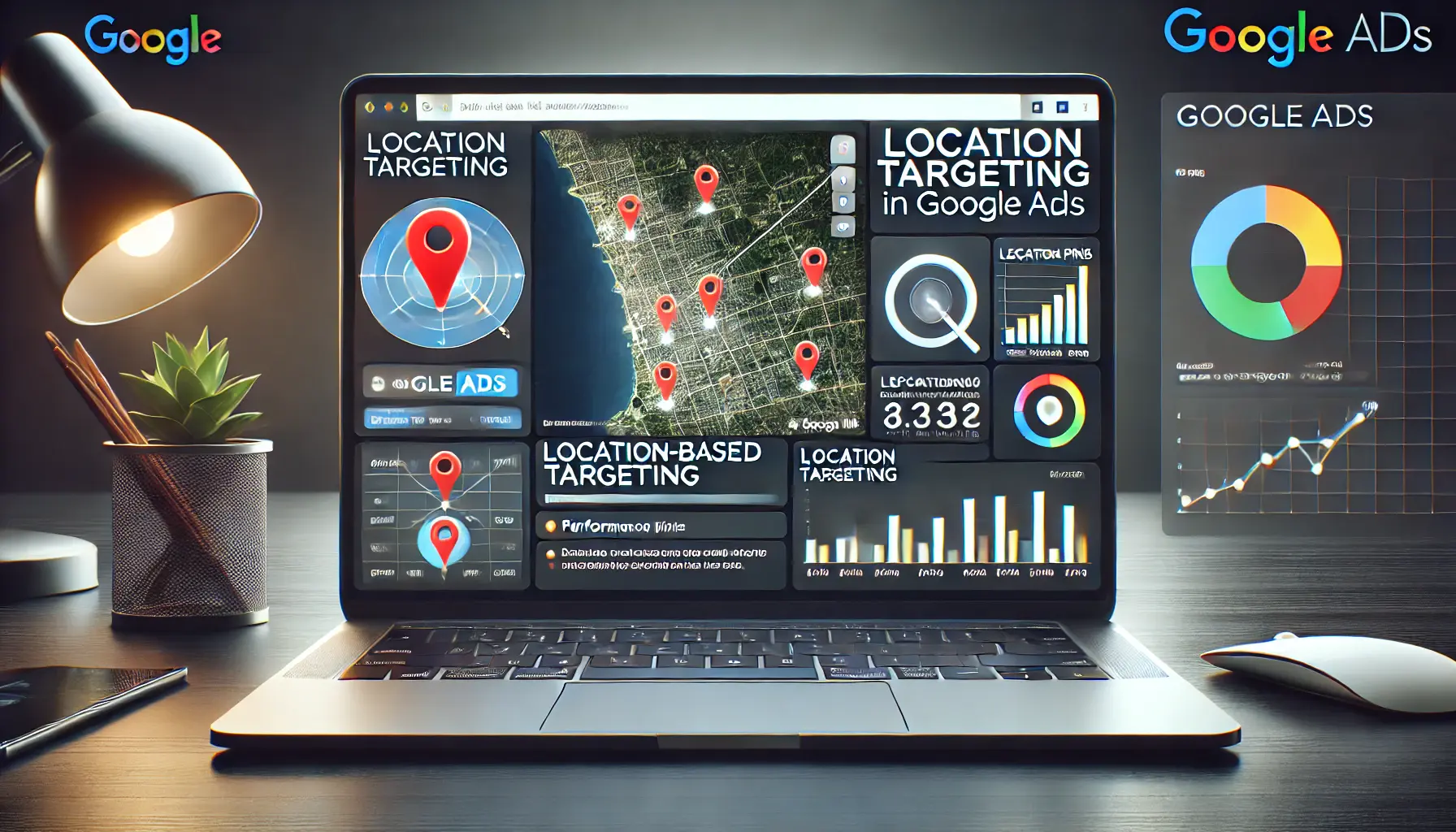
Location targeting in Google Ads helps marketers fine-tune their campaigns for maximum relevance and efficiency.
Benefits of Location Targeting in Google Ads
Using location targeting in Google Ads offers numerous advantages that help drive campaign success.
Here are some key benefits:
- Improved Relevance: Ads become more relevant to users when they include local offerings or deals specific to the user’s area.
- Increased Engagement: Customers respond better to ads targeted to their current location or nearby interests.
- Cost Efficiency: Targeting only specific areas helps you avoid wasted ad spend and focus on high-potential markets.
- Better Data Insights: Location targeting allows you to track performance across different regions, helping you understand where ads work best and where improvements are needed.

Location-based advertising benefits industries like retail, restaurants, healthcare, and hospitality by reaching nearby customers.
Industries Best Suited for Location-Based Advertising
While location-based advertising is beneficial for virtually any industry, certain sectors experience particularly strong outcomes from this approach:
- Retail: Stores can target local shoppers to promote events, sales, or special offers.
- Food and Beverage: Restaurants, cafes, and bars can capture the attention of nearby customers with timely ads.
- Healthcare: Clinics and medical services can reach people in the area, especially in cases of emergency or urgent care.
- Travel and Hospitality: Hotels and travel-related businesses can attract tourists or travelers looking for local accommodations and activities.
Location-based advertising in Google Ads can help businesses target precise audiences who are most likely to convert.
Location-based advertising enables businesses to deliver ads precisely based on a user’s location, making ads more relevant and impactful.
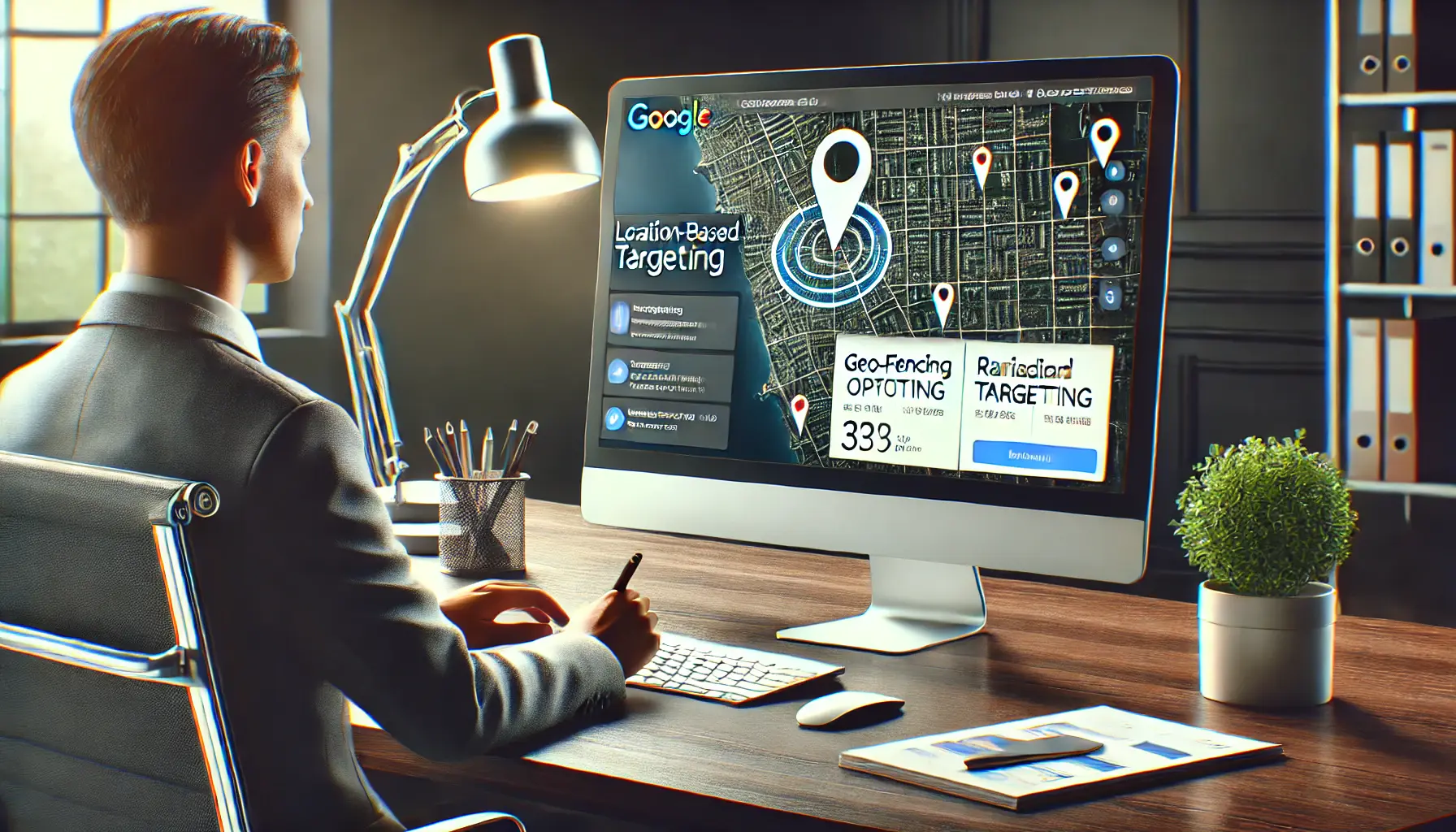
Geo-fencing and radius targeting techniques are essential for localized advertising success in Google Ads.
Targeting Techniques for Localized Advertising Success
Performing effective targeting techniques will help to maximize the potential of location-based advertising.
Google Ads offers a range of methods to ensure your ads reach the right people based on geographic locations.
This allows your ad to appear precisely in the place where it is most relevant.
Below are some key techniques for successful localized advertising.

Geo-fencing allows businesses to target customers within a specific geographic area for precise advertising reach.
Geo-Fencing for Precise Customer Reach
Geo-fencing allows advertisers to define a specific geographic boundary where ads will be shown.
This boundary could be as small as a city block or as large as a region, depending on your business goals.
Geo-fencing is especially effective for businesses operating physical locations, such as retail stores, as it enables the serving of ads to users who are physically close to their location.
This technique can drive foot traffic by delivering real-time promotions to people nearby.
For instance, a restaurant can create a geo-fence around its location and serve ads to passing users at peak dining hours, promoting special discounts or highlighting menu items.
Geo-fencing can be an excellent tool to increase walk-in customers and promote time-sensitive offers.

Radius targeting helps advertisers reach customers within a defined geographic area, ensuring proximity-based campaigns.
Radius Targeting for Proximity-Based Campaigns
Radius targeting is another powerful location-based strategy, allowing advertisers to create a radius around a specific location and reach users within that area.
This technique is highly customizable in Google Ads, allowing businesses to adjust the size of the targeted area based on their marketing objectives.
Businesses can further enhance this strategy by using bid adjustments to prioritize customers who are closer to their location.
This approach is especially useful for service-based businesses that rely on proximity, such as food delivery services or repair shops.
For example, a car repair shop might target users within a 10-mile radius, focusing on local customers who may have sudden needs for car repairs.
By focusing on nearby audiences, businesses can enhance ad relevance and increase conversion rates.
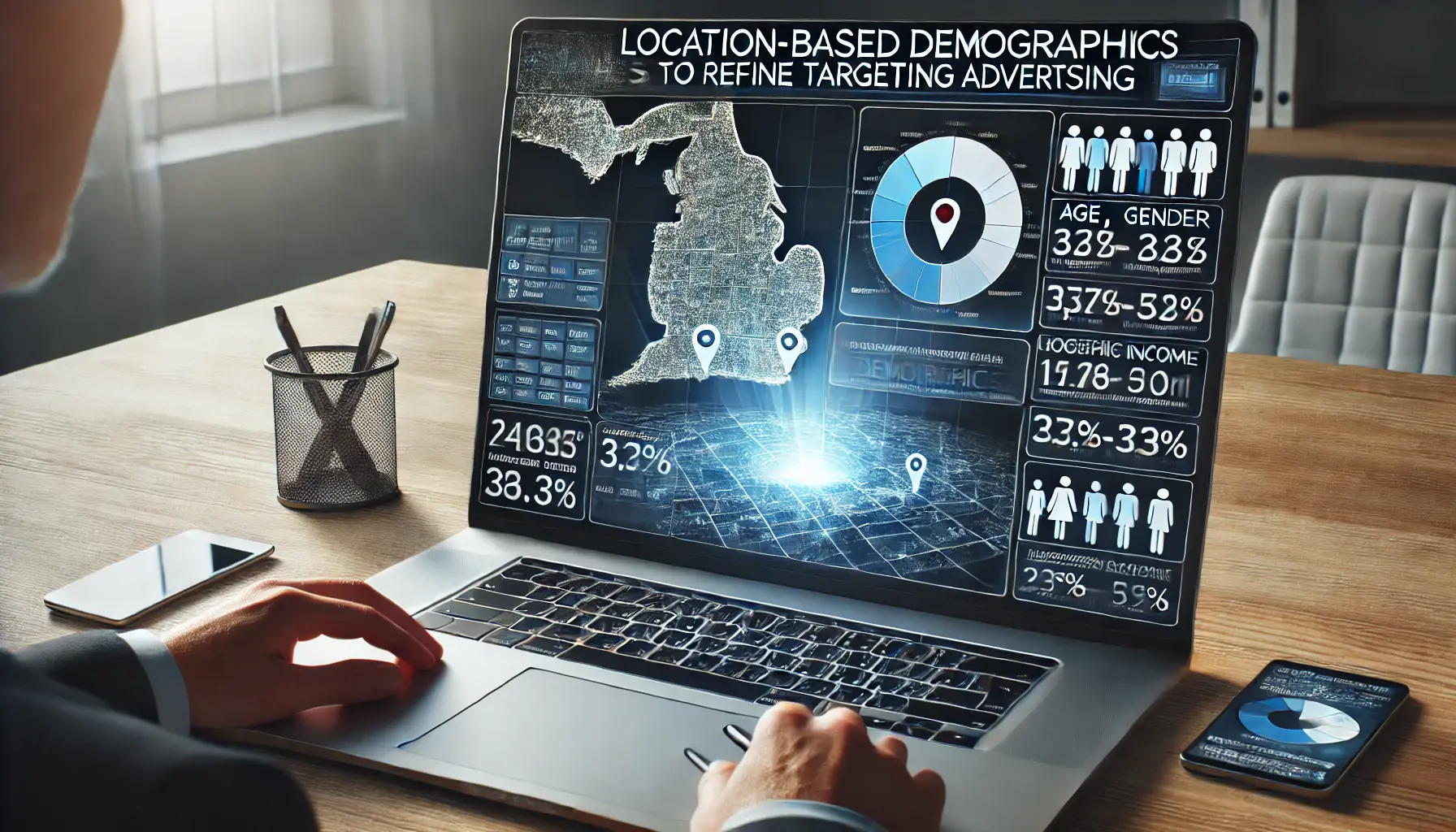
Location-based demographics refine targeting by incorporating factors like age, gender, and income for more precise advertising.
Location-Based Demographics for Better Targeting
Google Ads also offers the option to layer demographic targeting with location-based advertising, allowing businesses to target specific groups within a geographic area.
This can include factors like age, gender, and household income, which can be combined with location data to reach an audience that resembles an ideal customer profile more closely.
For instance, a luxury retailer may want to show ads to higher-income users within a specific area, ensuring their ads reach those people who are most likely to make a purchase.
This combination of demographic and geographic information aids in serving ads to audiences who are most likely to engage, making campaigns more effective and cost-efficient.
Employing these advanced targeting techniques in Google Ads will empower businesses to unlock the full potential of location-based advertising campaigns, allowing them to connect with their ideal customers exactly when and where it matters most.
Applying techniques such as geo-fencingA location-based service that triggers actions when a mobile device enters or exits a predefined boundary. and radius targetingA targeting strategy that focuses ads within a specific distance around a central point. can greatly increase foot traffic and online engagement by reaching nearby customers.
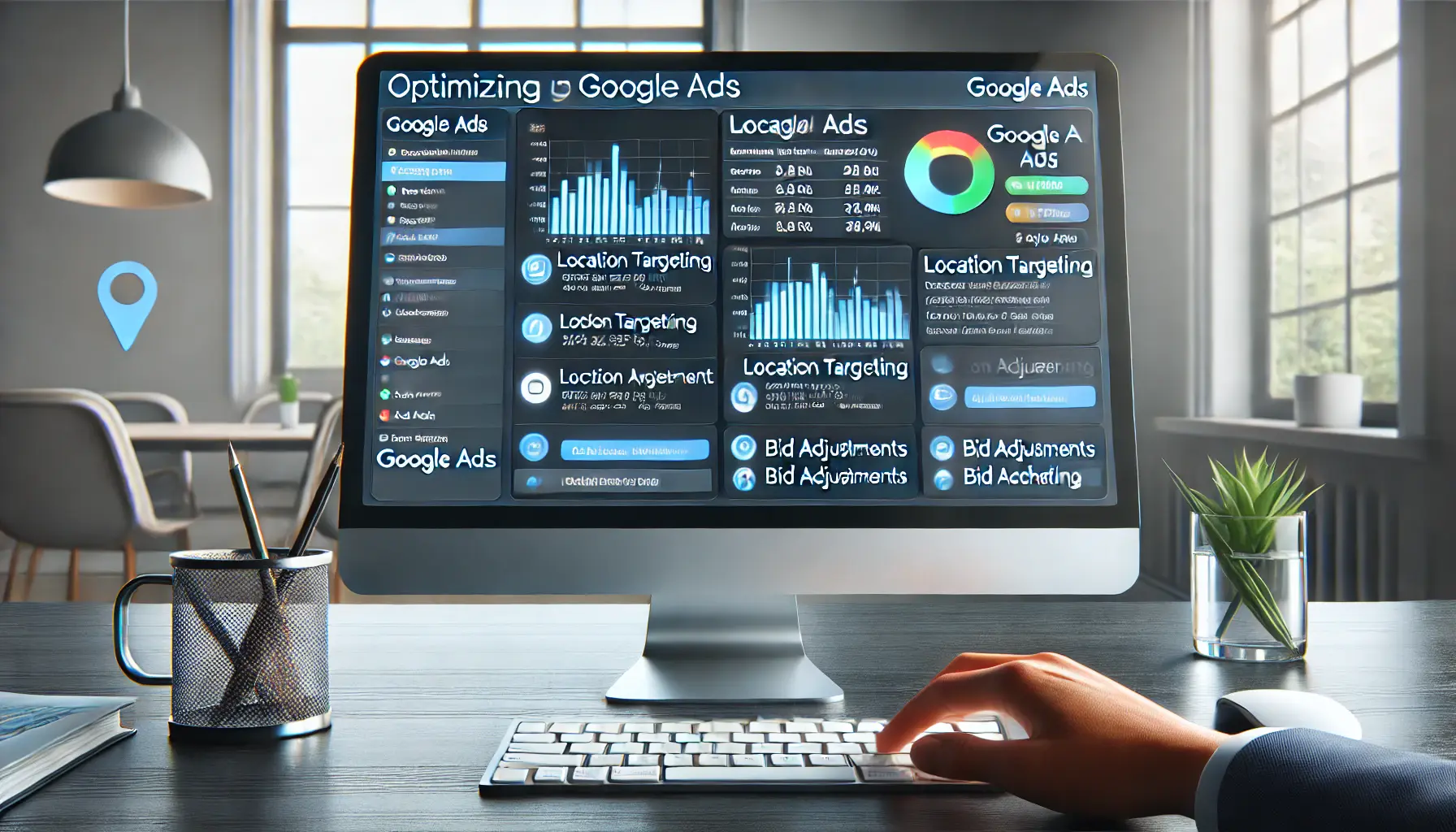
Optimizing Google Ads for location-based strategies involves setting location targeting, bid adjustments, and ad scheduling.
Optimizing Google Ads for Location-Based Strategies
The idea of location-based advertising requires businesses to optimize Google Ads for specific location-based strategies.
This encompasses setting up location targeting, adjusting bids, and using ad scheduling to reach the correct audience at the perfect time and place.
By optimizing these elements, businesses can improve the effectiveness of their ads, reduce costs, and boost return on investment (ROI).
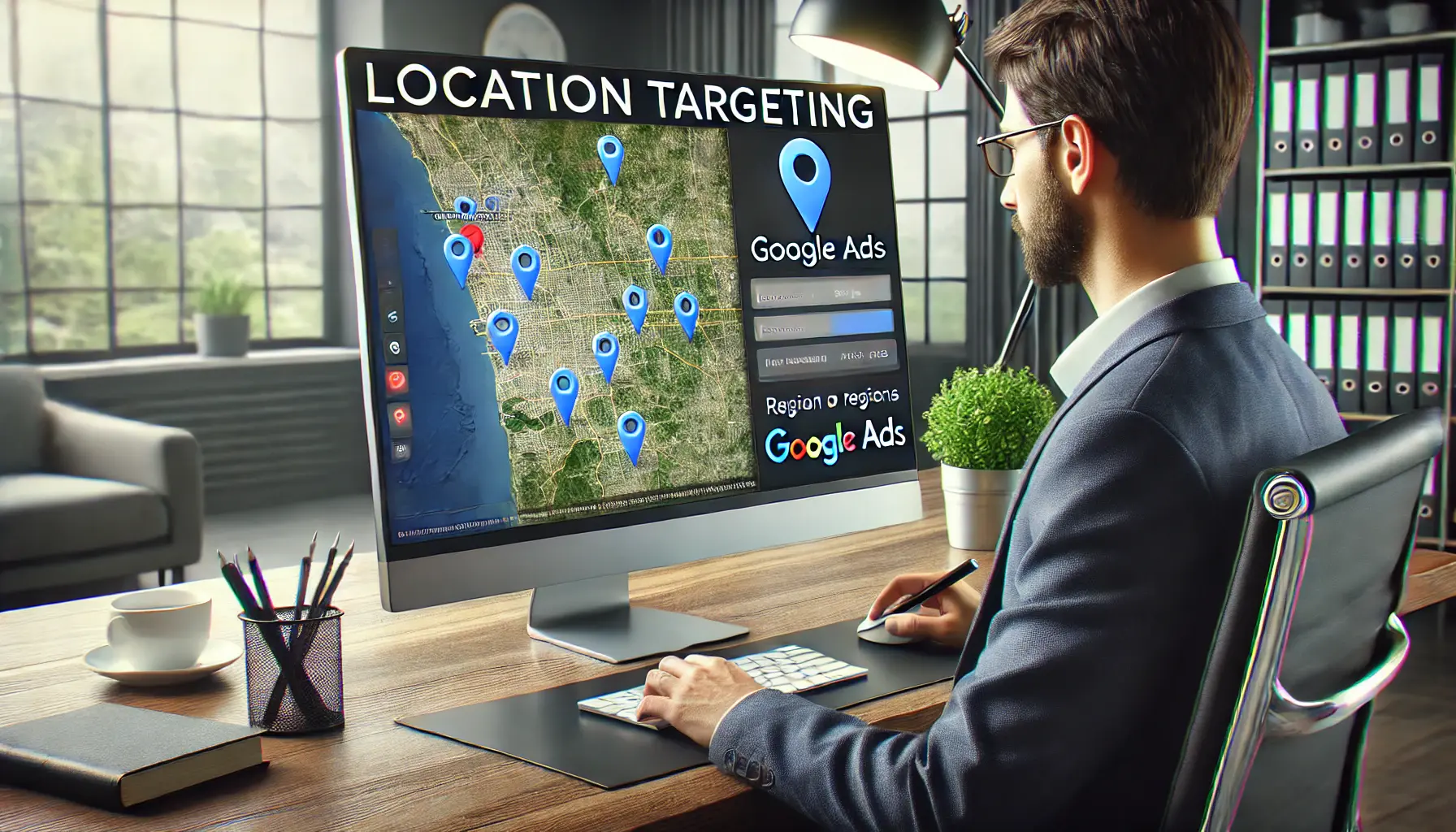
Setting up location targeting in Google Ads allows advertisers to select specific regions and areas to focus their campaigns.
Setting Up Location Targeting in Google Ads
Location targeting is one of the most effective ways to reach local audiences through Google Ads.
You can set up location targeting by choosing specific regions, cities, or even zip codes where you want your ads to appear.
Google Ads also allows for the exclusion of certain areas, ensuring that your ads do not appear in locations that may not be relevant.
This allows you to focus your ad spend on areas with the highest potential for customer engagement and conversions.
- Select Target Areas: Identify specific regions, cities, or neighborhoods where your potential customers are located.
- Exclude Irrelevant Locations: Exclude locations that do not align with your target audience to maximize ad spend efficiency.
- Use Advanced Location Options: Google Ads provides advanced location options to further refine your targeting, such as targeting people “in” a location or those who “show interest in” a particular area.
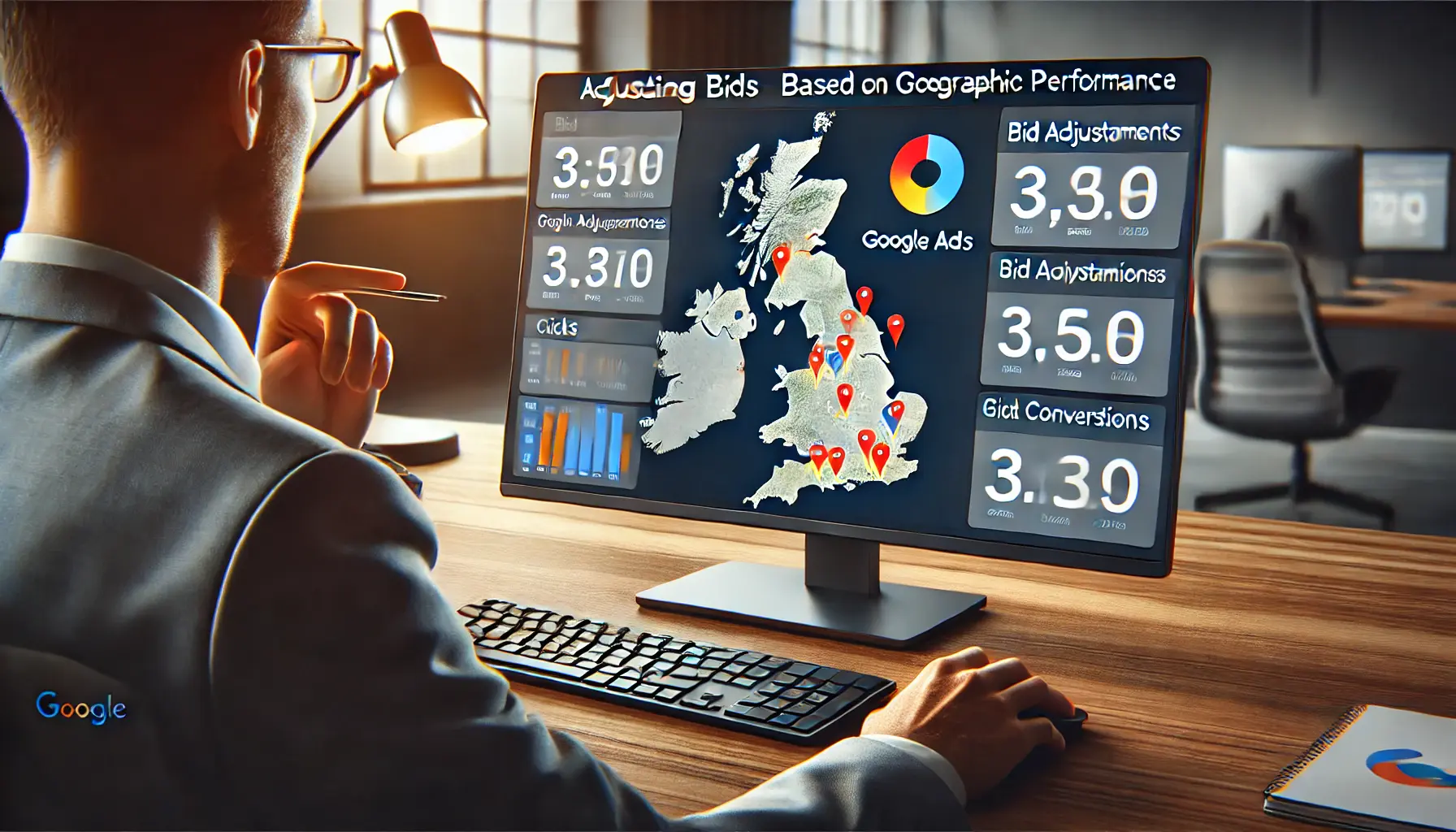
Adjusting bids based on geographic performance helps optimize ad campaigns by targeting high-conversion regions.
Adjusting Bids Based on Geographic Performance
One of the benefits of location-based advertising in Google Ads is the ability to adjust bids based on geographic performance.
By analyzing which locations yield the best results, you can allocate more budget to high-performing areas and reduce bids for regions with lower conversion rates.
Google Ads allows you to set bid adjustments for each targeted location, helping you optimize your ad spend.
For instance, if you notice that customers from urban areas convert better than those from rural regions, you can increase your bids for urban locations to ensure higher visibility in those locations.
This data-driven approach helps maximize ROI by focusing on areas with the highest potential for customer engagement.
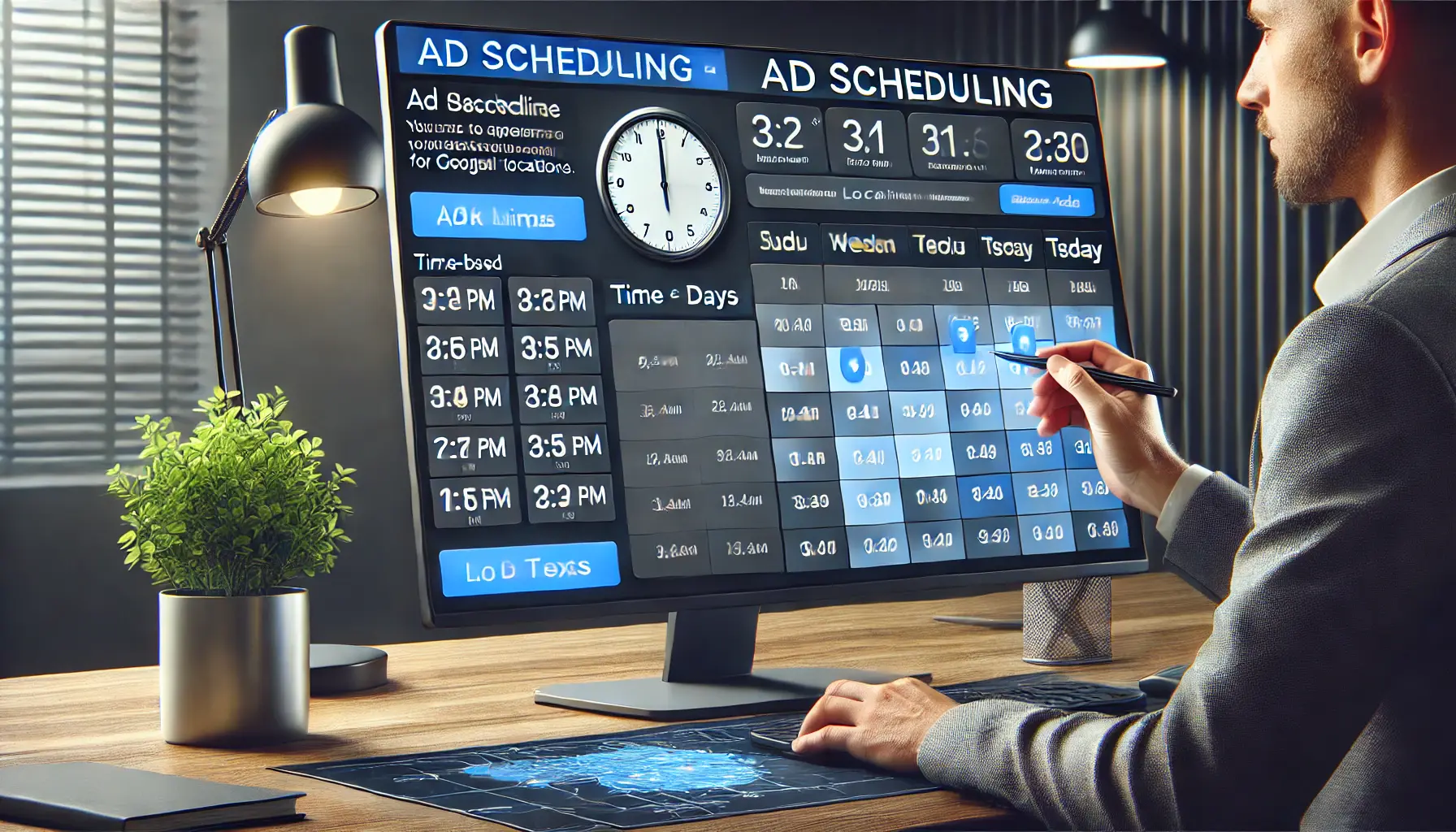
Ad scheduling allows advertisers to optimize their campaigns by targeting specific times and locations.
Utilizing Ad Scheduling for Time-Specific Locations
Ad scheduling, also known as daypartingThe practice of scheduling ads to appear only at specific times of day., allows you to control when your ads are displayed based on location-specific needs.
By analyzing customer behavior, such as peak shopping times, you can set your ads to appear only during certain hours of the day or on specific days of the week.
This helps avoid wasting ad budget during low-traffic periods while maximizing exposure during high-traffic times.
For example, a restaurant may schedule its ads to appear only during meal hours, reaching people when they are more likely to look for dining options.
This technique is particularly useful for businesses that experience time-sensitive traffic patterns and can significantly increase the relevance and efficiency of ads.
By implementing these optimization strategies within Google Ads, businesses can ensure that their location-based advertising campaigns are effective, cost-efficient, and tailored to reach the most relevant audiences.
Optimizing your ads with proper location targeting and bid adjustments can improve ad relevance and reduce costs in competitive areas.

Crafting compelling ad copy for local audiences involves targeting specific regional needs and incorporating local elements.
Crafting Compelling Ad Copy for Local Audiences
Creating engaging ad copy that resonates with local audiences is essential for the success of location-based advertising campaigns.
By tailoring your messages to reflect local culture, events, and preferences, you can increase relevance and drive higher engagement.
Here are some strategies to craft compelling ad copy for local audiences.

Incorporating local keywords and phrases helps make ad copy more relevant to regional audiences.
Incorporate Local Keywords and Phrases
Integrating local keywords and phrases into your ad copy helps connect with the audience on a personal level.
Mentioning specific neighborhoods, landmarks, or city names can make your ads more relevant to users in those areas.
For example, a bakery in Mersin might target locals with phrases like “Fresh pastries in Mersin” or “Best bakery near Mersin Marina.”
Local businesses should utilize Google Keyword Planner to discover the most active search terms locally and tailor their ads to match what customers are seeking.
This approach not only enhances ad relevance but also improves your Quality Score, potentially lowering costs per click.
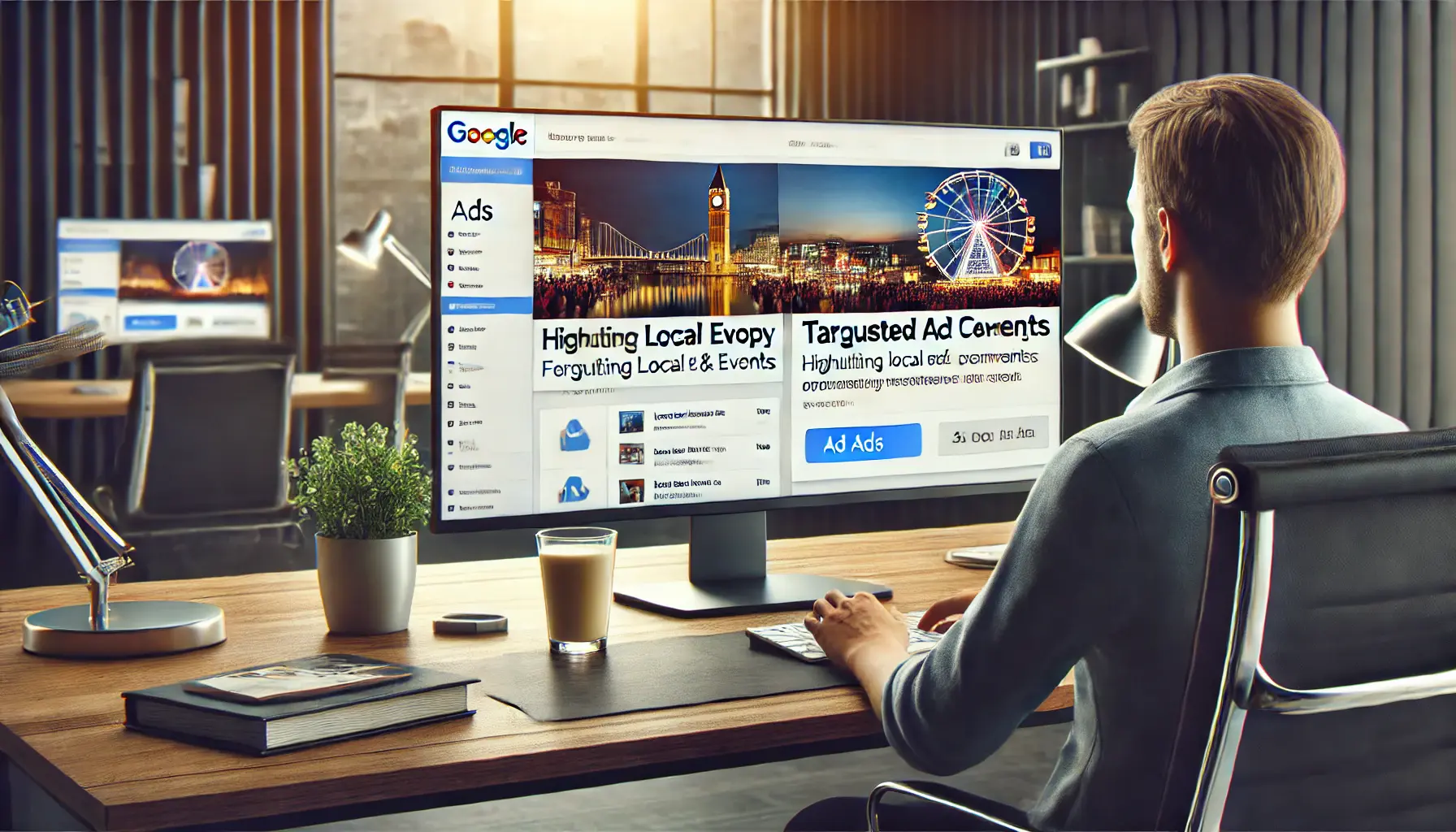
Highlighting local events and promotions helps tailor ads to engage regional audiences effectively.
Highlight Local Events and Promotions
Aligning your ad copy with local events or promotions can capture the interest of your target audience.
For instance, if there’s a local festival or market, you can create ads that mention special deals or products available during that time.
This creates a sense of urgency, encouraging immediate action.
Moreover, offering promotions unique to local customers, such as “10% off for Mersin residents,” can foster community engagement and loyalty.
Personalizing your offers to the local audience demonstrates that your business values and understands the community it serves.

Dynamic Location Insertion (DLI) personalizes ad copy to reflect the user’s geographic location, increasing ad relevance.
Utilize Dynamic Location Insertion
Dynamic Location Insertion (DLI) is a feature in Google Ads that automatically updates your ad copy to include the user’s geographic location.
This personalization makes your ads more relevant and can lead to higher click-through rates.
For example, an ad headline could dynamically change to “Top-rated plumbing services in [User’s City],” directly addressing the user’s location.
Implementing DLI involves using specific syntax in your ad copy, such as inserting placeholders that Google Ads replaces with the user’s location.
This technique saves time and ensures consistency across your campaigns, providing a personalized experience for each user.

Emphasizing local testimonials and reviews in ad campaigns enhances trust and relevance for local audiences.
Emphasize Local Testimonials and Reviews
Featuring testimonials and reviews from local customers in your ad copy can build trust and credibility.
Potential customers are more likely to engage with a business that has positive feedback from people in their community.
Adding statements like “Rated 5 stars by Mersin locals” or “Trusted by over 500 customers in Mersin” can give your ad extra appeal.
Encouraging satisfied local customers to leave reviews and showcasing these in your ads not only boosts your reputation but also demonstrates your commitment to serving the local community.
This social proof can be a powerful motivator for new customers to choose your business over competitors.
By implementing these strategies, you can create ad copy that resonates with local audiences, leading to increased engagement and conversions in your location-based advertising campaigns.
Using local keywords and dynamic location insertion can make ad copy more relatable and relevant to the audience’s location.

Continuous monitoring and optimization of location-based campaigns helps improve ad performance and reach.
Continuously Monitoring and Optimizing Your Location-Based Campaigns
Once an effective location-based advertising campaign is set up in Google Ads, continuous analysis and refinement are essential to further develop its effectiveness and optimize performance.
Businesses can achieve better conversions and utilize their advertising budgets more effectively by carefully observing data and making necessary adjustments.
Here are some steps to help you analyze and refine your location-based campaigns.
Tracking performance with location reports helps optimize location-based ad campaigns by analyzing geographic data.
Tracking Performance with Location Reports
Google Ads provides location reports that allow advertisers to monitor the performance of their ads across different geographic areas.
These reports offer insights into which regions are driving the most clicks, conversions, and engagement, helping you identify high-performing areas and those that may need improvement.
With these insights, you can focus your budget on the locations that deliver the best results.
- Analyze Key Metrics: Focus on metrics like click-through rate (CTR), cost per click (CPC), and conversion rate to understand the effectiveness of your ads in each location.
- Identify Top-Performing Areas: Allocate more resources to locations with high engagement and conversions.
- Monitor Low-Performing Regions: Investigate why certain areas have lower performance and consider adjusting or excluding them from your targeting.
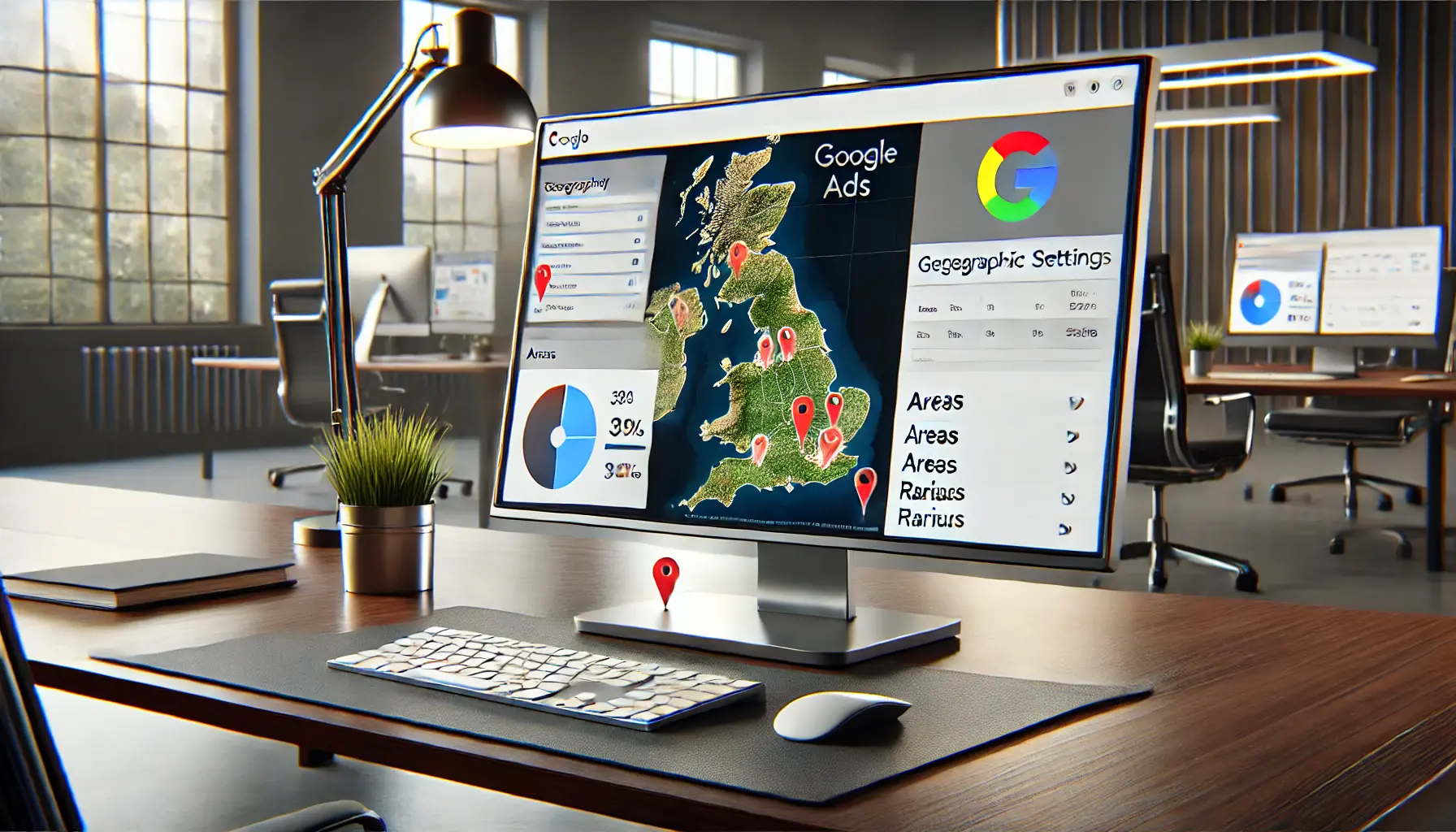
Testing and adjusting geographical settings helps refine targeting and optimize ad performance in specific regions.
Testing and Adjusting Geographical Settings
Testing different location-based settings can reveal insights into what works best for your campaign.
You can also test alternative targeting methods, such as expanding or reducing the radius of your ads or building on demographic filters within a location.
Testing helps you find the best way to reach your target audience and can uncover new opportunities.
Based on the test results, data-driven adjustments can be made, such as expanding successful targeting areas or narrowing the focus on high-performing regions.
Regularly testing and adjusting your geographical settings keeps your campaign relevant and competitive.

Scaling successful strategies to new markets helps expand the reach of high-performing campaigns to additional regions.
Scaling Successful Strategies to New Markets
Once you’ve identified effective strategies in certain locations, you can consider scaling them to new markets with similar demographics or interests.
By analyzing the characteristics of high-performing regions, you can identify comparable areas that might yield similar success.
This tactic allows you to scale while adhering to the principles that worked well in your original campaigns.
For instance, if a campaign is performing well in a major city, you could apply similar tactics to nearby urban areas or locations with similar customer profiles.
Scaling successful strategies can save time and resources by applying proven methods to new target areas.

Leveraging data-driven insights helps optimize advertising strategies and ensure continuous improvement in campaign performance.
Leveraging Data-Driven Insights for Continuous Improvement
Refining a location-based campaign is an ongoing process.
By regularly analyzing data and incorporating new insights, you can make informed decisions to enhance your campaign’s effectiveness.
This ensures your ads remain relevant, as market conditions and customer behaviors are constantly evolving.
Using Google Ads’ automated tools, like Smart BiddingGoogle Ads' automated bidding system that adjusts bids in real-time to maximize campaign performance. and dynamic ad adjustments, can help maintain optimized performance as you refine your campaigns.
With these tools and a focus on continuous data-driven improvement, your location-based advertising will continue to progress and improve.
Following these steps, businesses can effectively analyze, refine, and expand their location-based campaigns in Google Ads, achieving greater efficiency and better results.
Regularly analyzing and adjusting campaign settings ensures ongoing success and high performance in location-based advertising.

Location-based advertising strategies help target the right audience and optimize ad performance for maximum success.
Location-Based Advertising Strategies to Ensure Maximum Success
Location-based advertising with Google Ads offers a vital opportunity for businesses to reach audiences with precision and relevance.
This form of advertising allows firms to target potential customers at the right time and place.
From understanding the basics of location-based targeting to refining campaigns through continuous monitoring, each strategy enhances your ability to drive results.

Key takeaways for effective location-based advertising include analyzing performance data, targeting regions, and optimizing campaigns for success.
Key Takeaways for Effective Location-Based Advertising
To create a successful location-based advertising campaign, it’s essential to apply a multi-faceted approach.
Here are the major steps we discussed to transform your Google Ads campaigns:
- Geo-Targeting Techniques: Apply geo-fencing or radius targeting techniques to reach customers nearby and prompt immediate action.
- Compelling Localized Ad Copy: Engage your audience by incorporating local keywords into the ad copy, highlighting nearby events, and utilizing community testimonials.
- Optimize Your Ads for Time and Location: Use ad scheduling and bid adjustments based on geographic performance to improve cost-efficiency and relevance.
- Continuously Refine Campaigns through Ongoing Analysis: Regularly monitor performance with Google Ads location reports, edit settings, and test new approaches to maintain campaign efficiency.
- Scaling Successful Tactics in New Markets: Extend your successful strategies to comparable markets to maximize reach while adhering to the core principles of successful campaigns.

Data-driven optimization in Google Ads helps improve campaign performance by analyzing key metrics like clicks and conversions.
The Impact of Data-Driven Optimization in Google Ads
Through close monitoring of metrics such as click-through rates, conversions, and engagement, businesses can make necessary adjustments for peak performance.
Data provides insights into resource allocation, prioritizing high-performing areas, and adapting to evolving market conditions.
This approach ensures that your campaigns remain competitive and relevant in an ever-changing digital landscape.
Tools like Smart Bidding and dynamic ad adjustments can further streamline campaigns, allowing you to focus on the big picture while Google Ads optimizes performance based on real-time data.

Building long-term success with location-based strategies involves continuous analysis and optimization of campaigns over time.
Building Long-Term Success with Location-Based Strategies
Implementing a comprehensive location-based advertising strategy is not a one-time effort; it requires continuous optimization and adaptation.
This involves scaling, testing, and ongoing monitoring to support continued growth and a higher return on investment.
Location-based ads not only improve campaign performance but also strengthen your relationship with local audiences, building trust and loyalty in your brand.
Businesses of all sizes can leverage location-based advertising in Google Ads to drive effective and efficient campaigns that deliver real results.
By placing clear emphasis on location-based strategies, you can achieve optimal advertising success, reaching customers precisely when and where it matters most.
Implementing a multi-faceted approach, from geo-targeting to ad optimization, is crucial for effective location-based advertising in Google Ads.

The FAQ section for location-based advertising strategies helps address common questions about targeting, performance, and optimization.
Your campaigns can be managed by an agency specialized in Google Ads, check out our service page.
Location-Based Advertising Strategies FAQ
Below is a set of frequently asked questions about location-based advertising strategies through Google Ads.
Additional information is available to help you improve your campaigns further.
Location-based advertising targets customers based on their geographic location, using data to show ads relevant to a user’s proximity or specific area, improving engagement and conversion rates.
To set up location targeting in Google Ads, choose your preferred locations (such as regions or cities) during campaign setup, enabling you to tailor ads for specific geographic areas.
Geo-fencing allows you to target customers within a defined geographic area, driving immediate actions like store visits by delivering highly relevant, localized offers in real-time.
Yes, Google Ads allows bid adjustments based on location performance, letting you increase bids for high-performing areas to maximize engagement and decrease them for low-performing regions.
Ad scheduling, or dayparting, enables you to run ads during peak engagement times, improving ad relevance and budget efficiency by showing ads when customers are most likely to respond.
Dynamic Location Insertion automatically customizes your ad copy to display the user’s location, personalizing ads and potentially increasing click-through rates through localized relevance.
Local keywords make your ad copy more relatable to users in proximity, helping establish a personal connection by referencing specific locations or neighborhoods and increasing engagement.
Yes, successful location-based strategies can be scaled to target markets with similar demographics, allowing you to replicate effective tactics in new areas.
Data-driven insights on metrics like CTR and conversions across regions allow precise adjustments to campaign goals, focusing efforts on high-performing locations.














